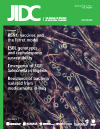Clinical presentation of tuberculoid leprosy in an epidermodysplasia verruciformis patient
DOI:
https://doi.org/10.3855/jidc.2269Keywords:
Epidermodysplasia verruciformis, papillomavirus, Mycobacterium leprae, DQB1*0301/ 0501HLA allelesAbstract
Epidermodysplasia verruciformis (EV) is triggered by a variety of mechanisms that at least partly include genetic background. We present a Brazilian man with a 30-year history of flat, wart-like lesions with clinical, histopathological, and evolutive aspects consistent with papillomavirus (HPV)-associated EV. Histological analysis of the wart lesions showed epidermis with hyperkeratosis, regular acanthosis, hypergranulosis, and cells with abundant basophilic cytoplasm. Moreover, a perivascular lymphocytic infiltrate was found in the superficial dermis, consistent with a viral wart. Type-2-HPV DNA was detected in various fragments of skin-wart lesions using the polymerase chain reaction (PCR). Two years after the EV diagnosis, the patient presented with an anesthetic well-demarcated, erythematous and mildly scaly plaque on his right forearm. A histopathological analysis of this lesion demonstrated the presence of a compact tuberculoid granuloma. Ziehl-Neelsen staining demonstrated the presence of rare acid-fast bacilli and confirmed the tuberculoid leprosy diagnosis. The patient's Mitsuda Intradermal Reaction was positive. To elucidate the possible mechanism involved in this case of EV, we genotyped the HLA genes of this patient. DQB genotyping showed the polymorphic HLA alleles DQB1*0301 and 0501. The patient was treated with a paucibacillary multi-drug therapy scheme, and the disease was cured in six months. This report describes an EV patient with an M. leprae infection, confirming that tuberculoid leprosy patients possess a relatively specific and efficient cell-mediated immunity against the bacillus and, therefore, localized forms of the disease. Moreover, we show the possible involvement of the polymorphic HLA alleles DQB1*0301 and 0501 in EV induction mechanisms.
Downloads
Published
How to Cite
Issue
Section
License
Authors who publish with this journal agree to the following terms:
- Authors retain copyright and grant the journal right of first publication with the work simultaneously licensed under a Creative Commons Attribution License that allows others to share the work with an acknowledgement of the work's authorship and initial publication in this journal.
- Authors are able to enter into separate, additional contractual arrangements for the non-exclusive distribution of the journal's published version of the work (e.g., post it to an institutional repository or publish it in a book), with an acknowledgement of its initial publication in this journal.
- Authors are permitted and encouraged to post their work online (e.g., in institutional repositories or on their website) prior to and during the submission process, as it can lead to productive exchanges, as well as earlier and greater citation of published work (See The Effect of Open Access).








